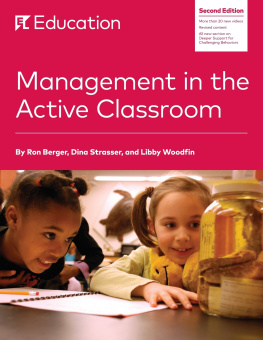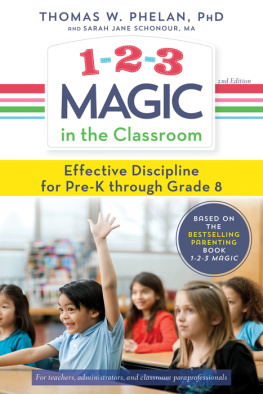Discipline without Anger
A New Style of Classroom Management
Doug Campbell
ROWMAN & LITTLEFIELD EDUCATION
A division of
Rowman & Littlefield Publishers, Inc.
Lanham New York Toronto Plymouth, UK
Published by Rowman & Littlefield Education
A division of Rowman & Littlefield Publishers, Inc.
A wholly owned subsidiary of The Rowman & Littlefield Publishing Group, Inc.
4501 Forbes Boulevard, Suite 200, Lanham, Maryland 20706
www.rowman.com
Estover Road, Plymouth PL6 7PY, United Kingdom
Copyright 2012 by Doug Campbell
All rights reserved. No part of this book may be reproduced in any form or by any electronic or mechanical means, including information storage and retrieval systems, without written permission from the publisher, except by a reviewer who may quote passages in a review.
British Library Cataloguing in Publication Information Available
Library of Congress Cataloging-in-Publication Data
Campbell, Doug, 1972
Discipline without anger : a new style of classroom management / Doug Campbell.
p. cm.
Includes index.
Summary: As times and students change, teachers are finding that the old methods of anger and intimidation are no longer working for classroom management. Discipline without Anger shows teachers how to successfully manage student misbehavior so that they can be free to teach at their full potential. Without a change, our schools and students will continue to suffer the consequences Provided by publisher.
ISBN 978-1-61048-342-1 (hardback) ISBN 978-1-61048-343-8 (paper) ISBN 978-1-61048-344-5 (electronic)
1. School disciplineUnited States. 2. Classroom managementUnited States. 3. Behavior modificationUnited States. I. Title.
LB3012.2.C35 2012
371.5dc23
2011051859
 The paper used in this publication meets the minimum requirements of American National Standard for Information SciencesPermanence of Paper for Printed Library Materials, ANSI/NISO Z39.48-1992.
The paper used in this publication meets the minimum requirements of American National Standard for Information SciencesPermanence of Paper for Printed Library Materials, ANSI/NISO Z39.48-1992.
Printed in the United States of America
This book is dedicated to Betty Harper, my supervising teacher during my student teaching assignment at Hillcrest High School in Simpsonville, South Carolina. Mrs. Harper showed me what a caring, enthusiastic, professional teacher looks like. She also encouraged me on a regular basis and helped me develop confidence in my teaching abilities.
It is also dedicated to you, current and future teachers who want to be able to teach and inspire young people without having to rely on anger and intimidation to keep order in your classrooms.
Preface
I am currently on a mission. My mission is to help transform the way most teachers approach classroom management. The old ways of using anger and intimidation to discipline students are no longer effective, and our students are paying the price. A new era of student behavior demands a New Style of classroom management for teachersone where organization, fairness, and clarity are the basis, not fear and intimidation. My goal is that teachers everywhere will learn to drastically lower the stress that accompanies poor management skills and unlock their gifts of teaching. I want to save our teachers and our schools from falling apart because of the unsuccessful classroom management techniques being used in many places.
I had two main inspirations for beginning my study of classroom management. First, my study began a few years ago when I had three straight terms teaching a class that made me want to quit because of their misbehavior. The interesting thing about these classes is that there was very little extreme misbehavior taking place. There were no threats, no fights, and no weapons taken out. These classes simply had a high frequency of more simple misbehaviors. I tried to use intimidation and meanness to put a stop to the misbehavior, but this just caused me stress and had little effect on the students behavior anyway. I explored and experimented until I eventually developed the plan for classroom management that is described in this book. The plan worked so well for me and for other teachers at my school that some of them encouraged me to write a book about my experiences.
My second inspiration for the book may be surprising. It comes from one of my favorite television shows, Supernanny . I have never had kids of my own, but I love this show. I have always been fascinated by discipline, whether in the classroom or in the home. The star of the show is Jo Frost, who goes into homes that are in a state of chaos because of out-of-control children. She observes the families and comes up with sensible discipline plans for them. The results are astounding, as the parents learn how to successfully bring order to their homes. What she does is not rocket science; she just teaches the families how to create an organized discipline plan.
After discovering Supernanny , I thought to myself, Wouldnt it be great if someone could do the same thing that she does for families, but in classrooms instead? My goal is to help totally transform the way teachers handle student behavior problems, either as a result of reading this book, or through individual training to help teachers develop effective discipline plans.
The main objective for this book is not to turn teachers into great disciplinarians, although that can be a benefit of using the strategies being taught. The ultimate goal is to help teachers whose gifts for teaching are being hindered because of their inability to successfully manage classroom behavior. Maybe I can even help you.
Happy teaching,
Campbell (the Discipline Doctor)
Introduction
Why a Different Approach Is Needed: To Be (a Witch), or Not to Be, That Is the Question
There are many more people with a gift for teaching than there are with a gift for classroom management.
Doug Campbell
Early Days
And we would like to say good-bye to Doug Campbell. He did a good job for us, had some problems with classroom discipline...
Ugh. I cringed as I heard my principal saying those words at the faculty meeting at the end of my second year as a high school teacher. It was the spring of 1997, and I was leaving my job teaching social studies in South Carolina to teach math in North Carolina. How embarrassing. I did not consider myself weak in the area of classroom management, but it was definitely not a strength of mine at this stage of my career. I actually had only one mild incident of student misbehavior that year that involved the principal, but it was enough for him to associate me with having a problem.
The principal was right, though. Classroom management was a weakness of mine. Yes, I did have other skills that were necessary for successful teaching, but this was definitely not one of them. After completing my secondary teacher certification and being halfway through a masters degree in education, this glaring weakness still existed. Despite all of that training, I had had very little actual instruction in how to manage a classroom. I knew that there had to be a way to solve this great mystery. Twelve years would pass before I found any significant answers.
The Revelation Comes
Not long into my teaching career I made a comforting discovery. I found that I was not the only teacher having difficulty with classroom management. Everywhere I looked, teachers were facing the same challenges in their classrooms, many with unsuccessful results. Almost every teacher that I knew had some issue with student misbehavior. It did not matter what grade they were teaching, where they lived, or how wealthy the families were in the communities they taught. The challenges were the same.
Of course, the severity of the problems that some teachers face is different from others, but the basic issues are the same everywhere. The main concern of most teachers comes down to one issue: How do I handle student misbehaviors in my classroom?










 The paper used in this publication meets the minimum requirements of American National Standard for Information SciencesPermanence of Paper for Printed Library Materials, ANSI/NISO Z39.48-1992.
The paper used in this publication meets the minimum requirements of American National Standard for Information SciencesPermanence of Paper for Printed Library Materials, ANSI/NISO Z39.48-1992.